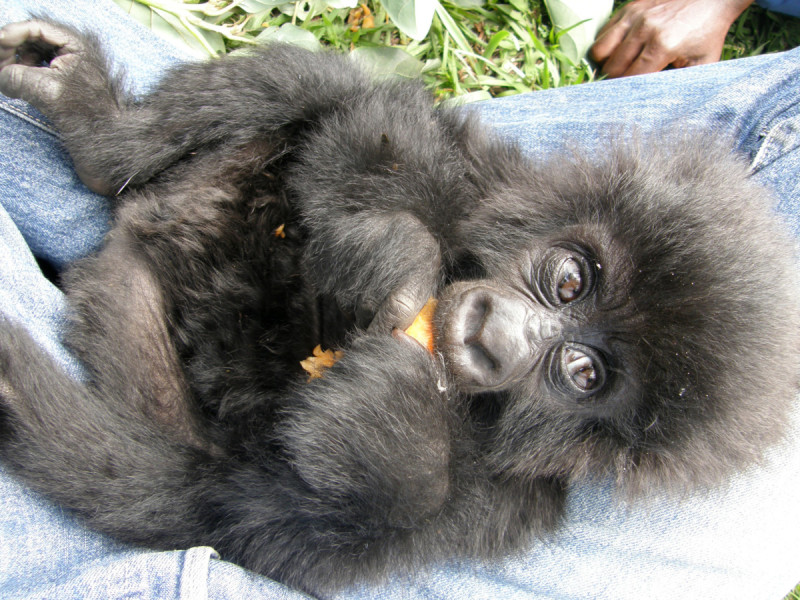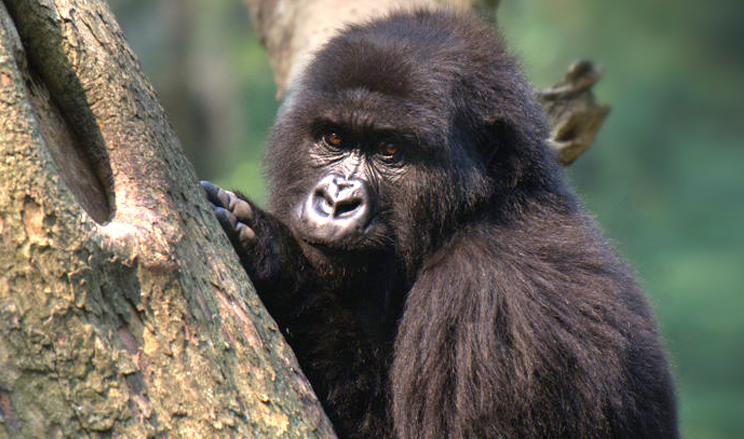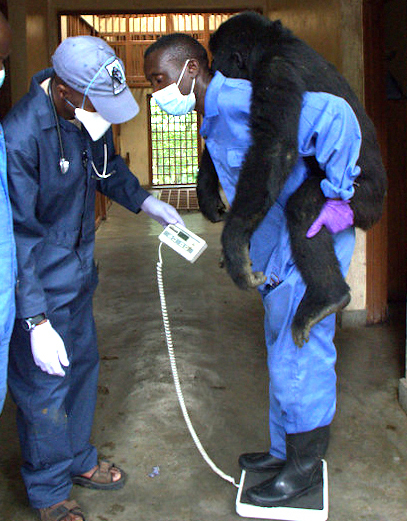Ndeze
Virunga National Park’s Rugendo family welcomed a new mountain gorilla into their family group on February 17, 2007. The infant of female Safari and silverback Senkwekwe was named Ndeze after a local chief who had died two days earlier. Her birth was celebrated in the international media as a hopeful sign for mountain gorillas in the park: just a month earlier, the park made headlines when two mountain gorillas were killed by rebel soldiers.On July 22, criminals associated with the park’s illegal charcoal trade shot and killed 5 members of the Rugendo family, including Safari and Senkwekwe. After the massacre, the blackback Mukunda rescued baby Ndeze from her dead mother and made off with her to safety. Because Mukunda was a male and could not produce milk to feed Ndeze, the Gorilla Doctors made the decision to dart Mukunda with an anesthetic drug so that they could recover Ndeze and bring her into captivity.


Ndeze joined the younger orphan Ndakasi and caretaker Andre Bauma at a temporary housing facility in Goma, DR Congo. Despite the trauma of the attack and being severely dehydrated, Ndeze quickly recovered. Ndeze proved to be an easy patient: she was sturdy and healthy and easily accepted medication for her common infant disorders like a sore throat or mild diarrhea.Under the watchful eyes of the Virunga National Park caretakers and the Gorilla Doctors, the two babies grew into playful, mischievous youngsters. In December 2009, Ndeze and Ndakasi journeyed back to Virunga National Park where they moved into the newly built Senkwekwe sanctuary (named after Ndeze’s father Senkwekwe) at the park’s headquarters. No longer confined to a small compound in noisy, crowded Goma, the two gorillas reveled in their forest playground, gleefully swinging from the branches of the tallest trees while their human caretakers watched with awe—and anxiety—from the ground.Ndeze 5One year later, in November 2010, Ndakasi and Ndeze gained two new mountain gorilla neighbors: older orphans Maisha and Kaboko, who had been living at the Gorilla Doctors’ orphan care facility in Rwanda for several years, were moved into an adjacent large forest enclosure right next door. Ndakasi and Ndeze climbed to the tops of the trees in their enclosure and studied Maisha and Kaboko’s behavior intently. The process of integrating the two pairs of gorillas into one family group had begun.
Of the two younger gorillas, Ndeze is the clear leader. She was the first to make peace with Maisha, all the while seeking to protect her frightened younger sibling. Ndeze frequently explores the gorillas’ forest enclosure with Maisha while Ndakasi stays closer to the human caretakers at the indoor enclosure. When the three come together, Ndeze stays by Ndakasi’s side. We hope Ndeze continues to bridge the gap between the older and younger gorillas and helps Ndakasi grow more confident.

Sadly, on July 25, 2012, Kaboko, who had a history of gastrointestinal problems, suddenly became very ill and passed away. Due to intense fighting between armed groups near the Senkwekwe Center, the Gorilla Doctors were not able to reach him in time. Thankfully, Ndeze, Ndakasi, and Maisha remained safe and healthy during this difficult time thanks to their dedicated Virunga National Park caretakers. Bringing the orphans together was more complicated than one might think. In the wild, a family group’s dominant silverback, the strongest and most experienced male, helps determine the social structure of the family and the ranking of the different members. In the case of these four mountain gorilla orphans, there was no silverback: Maisha held the highest social ranking, but had no serious leadership experience. Kaboko, the sub-adult male, was a moody adolescent. Ndakasi and Ndeze had never interacted with bigger gorillas before, and were quite convinced they were the queens of their realm.The orphans were brought together in an indoor enclosure with the two pairs residing in two rooms separated by bars so that they could see each other up close but not touch. Gradually, over a period of many weeks, the young gorillas were allowed to share the same space. There was much angst, yelling, and confrontation while the two youngsters learned to accept Maisha’s authority, and Maisha learned to protect Ndeze and Ndakasi from the mischievous Kaboko. However, the four gorillas learned to live together in the same enclosure, venturing outdoors during the day and sleeping indoors in the evening.
In late June 2013, another infant male mountain gorilla was rescued outside of Virunga National Park. Matabishi was found alone in a cornfield with a large wound on his back (possibly due to a rope restraint) suggesting he may have been a victim of gorilla trafficking and had been held captive by poachers for several weeks. Under the Gorilla Doctors medical care, Matabishi’s health improved and after a period in quarantine, he was integrated into the group with Maisha, Ndeze, and Ndakasi. Maisha immediately appointed herself as the infant’s surrogate mother and the pair are never far apart. Ndeze and Ndakasi display occasional bouts of jealousy, but Maisha is always quick to defend the new youngster in the group.
In the summer of 2017, the little orphan family suffered another loss when Maisha became extremely ill and passed away after many medical interventions and different types of treatment to try to save her. At the same time, another baby mountain gorilla, Yalala, who had been severely injured by a poacher’s snare, came into Gorilla Doctors medical care. Unfortunately, the injuries sustained from the snare were so severe that Yalala’s foot had to be amputated. It took several months for her to recover and learn to move around confidently in her enclosure and she is now ready to be integrated into the family of orphan mountain gorillas. We hope that Ndeze, Ndakasi and Matabishi will happily welcome Yalala into the group and the foursome will continue to thrive at the Senkwekwe Center.


 Donate
Donate